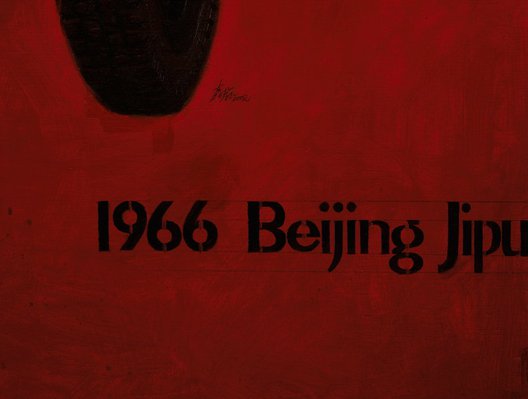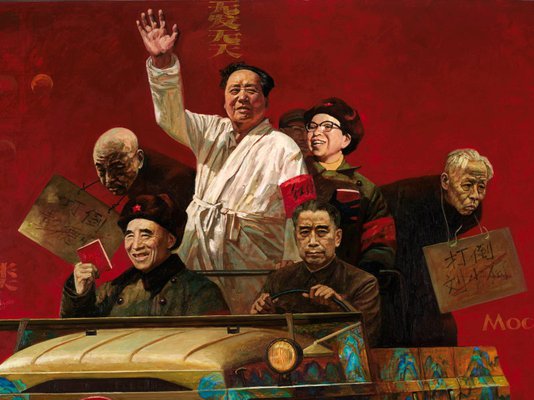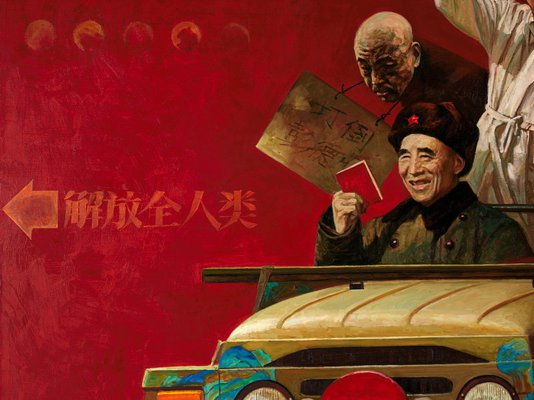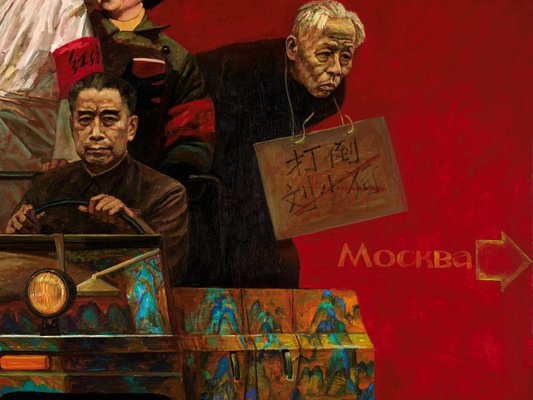



-
Details
- Other Title
- 1966 北京吉普 #2
- Place where the work was made
-
China
- Cultural origin
- China
- Date
- 2002
- Media category
- Painting
- Materials used
- oil on canvas
- Dimensions
- 198.0 x 198.0 cm
- Signature & date
Signed and dated in Chinese, "嘉蔚[Jiawei] 2002".
- Credit
- Gift of Sir Roderick and Lady Gillian Deane 2022
- Location
- South Building, ground level, Asian Lantern galleries
- Accession number
- 353.2022
- Copyright
- © SHEN Jiawei
- Artist information
-
Shen Jiawei
Works in the collection
- Share
-
-
About
In the painting, a reluctant Zhou Enlai (former Premier) is behind the steering wheel, while Lin Biao (third-ranking Marshall, pivotal in China’s communist victory) sits alongside holding his copy of Mao's Little Red Book. Behind them, a jubilant Jiang Qing (Mao’s wife) stands next to Mao who is wearing a dressing gown. In the background, a shadowy Kang Sheng (a member of the Gang of the Four) is seeing off his two most famous prisoners: Liu Shaoqi and Peng Dehuai (both prominent revolutionaries).
Shen completed a similar painting in 2001 but was not satisfied with the result because the red background turned out to be darker than expected. In 2002, he painted a variation: 1966 Beijing Jeep #2, in which a pure crimson was used for the background. The bumper bar of the jeep is decorated with a design similar to that often seen on a Qing dynasty's court robe: a red-sun rising from the ocean, while the visible side of the jeep to the right bears the motif copied from the famous classic painting of Landscape of thousands of li by Wang Ximeng (1096-1119) of Northern Song dynasty.
Going against three-dimensional spatiality, on the fictional two-dimensional flat surface of the canvas, directions are established with well-known Cultural Revolution slogans. A sign written in Chinese on the left reads: "Jiefang Quan Renlei“ [Liberate the Whole of Mankind], and on the right is a sign for “Moscow” written in Russian. Two vertical lines in Chinese can been seen in the centre above Mao's head and below the jeep. The top line is Mao’s famous saying: "Wu Fa Wu Tian" [come from a slang: a monk holds an umbrella, no hair no sky, implying no respect for law and order]. The bottom line being the most chanted words wishing Chairman Mao's longevity: "Jingzhu nin laorenjia wanshou wujian wanshuwu" [meaning wishing you, respected elderly, live for tens of thousands year and forever].
At first glance the painting seems to be a visual documentation recording the fates of several key figures in modern Chinese history, it also comments on the ironic or satirical twist of the Chinese Cultural Revolution era(1966-76) when some liberators were turned into prisoners in power struggle within the Chinese Communist Party. As scholar Wang Yiyan summarised well: "In Beijing Jipu [Jeep] #2, the statuesque figure of Mao in his pyjamas dwarfing other Party power brokers is an enigmatic emblem of the ultimate 'proletarian dictatorship' in Chinese memory, whereas the Beijing Jeep was the status symbol and the location of political power struggles during the Maoist period". The clever usage of popular historical motives representing imperial China seems to suggest these power games are deeply and widely embedded in Chinese history and culture.
Shen Jiawei became a practicing artist at age of 20 and is a celebrated figurative and history painter winning numerous awards both in China and Australia. Before migrating to Sydney in 1989, he worked in the Heilongjiang Corps of the People's Liberation Army in northeast China as a farmer and artist in early 1970s, and as a set design and studio artist in early 1980s. He went to do postgraduate studies in the Oil Painting Department of the Central Academy of Fine Arts (CAFA) in Beijing between 1982 and 84, and became a member of the National Artist Association of China in 1982. He was a Board member of the Hazelhurst Regional Gallery and Arts Centre between 2012-21.
Shen is well known for his oil painting on historic subjects in academic style. He regards historical paintings as the responsibility of an aware and contributing citizen in both Chinese and Australian societies. Since arriving at Sydney, Shen has held over a dozen solo exhibitions in public institutions, such as the University of Sydney and 4A, and actively participated in group exhibitions, including Archibald and Darling Portrait finalists exhibitions.
Shen had received a large number of commissions of painting portraits of important public figures, including Pope Frances for Australian Government, Hon John Howard, Governor General Sire Peter Cosgrove, Hon David Hawke MP, Speaker of the House Representatives for the Australian Parliament House, Crown Princess Mary of Denmark and Gordon Darling for the National Portrait Gallery.
Shen’s works are collected by significant public institutions, including National Art Museum of China, National Museum of China, Holy See Art Collection, Vatican, National Portrait Gallery of Australia, The University of Queensland Art Museum, University of Sydney, Western Sydney University.
-
Places
Where the work was made
China
-
Exhibition history
Shown in 1 exhibition
Correspondence, Art Gallery of New South Wales, Sydney, 10 Sep 2022–2024
-
Provenance
Roderick and Gillian Deane, 2002-Dec 2022, Sydney/New South Wales/Australia, purchased from the artist through Gallery 4A. Donated to the Art Gallery of New South Wales, Sydney, December 2022.

